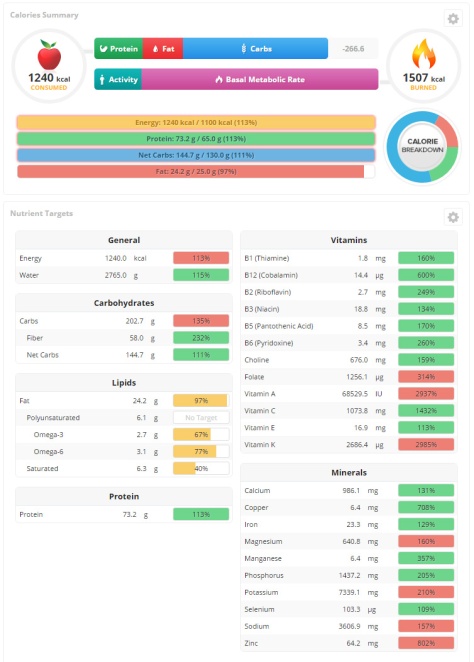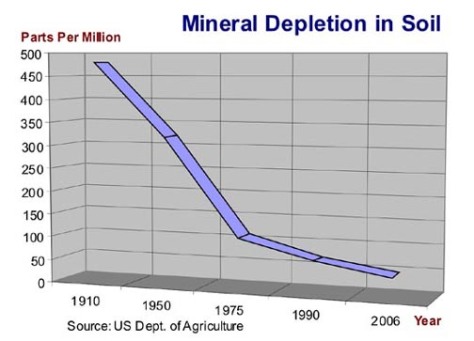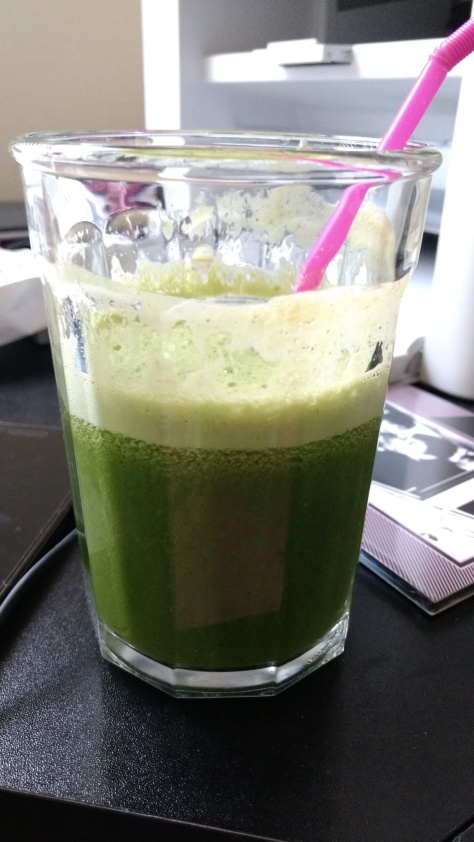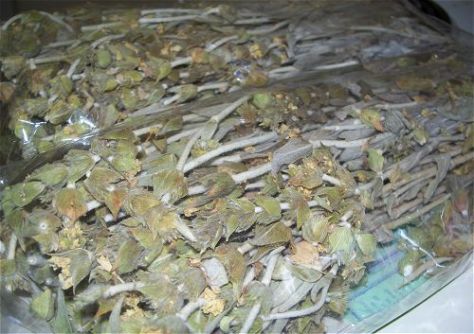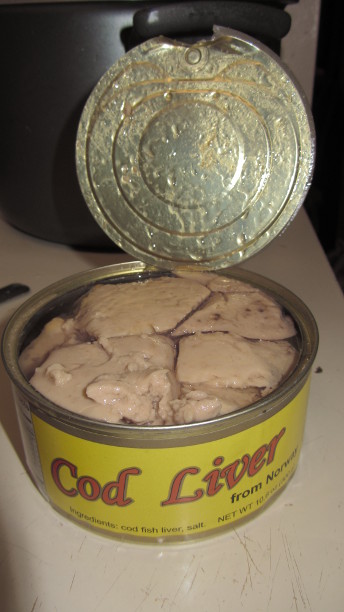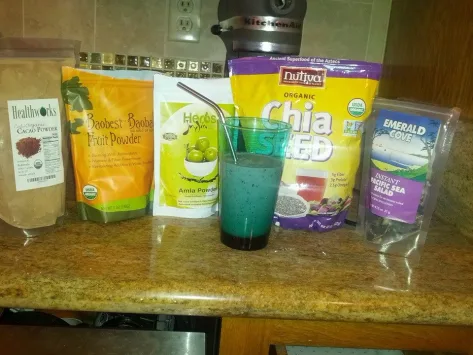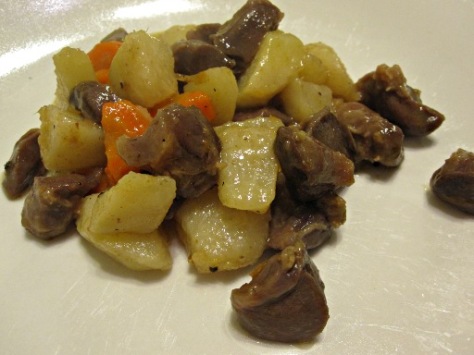Lost 25 lbs so far, in a little bit over two months and I’m symptom-free for the first time in 17 years. Still, I have another 20 lbs to lose and a few more things to still fix. I’m getting there. Here’s my colorful breakfast today. Beans is the only high-carb food I eat anymore, since my gut needs it. Love them with well-fermented kimchi. Overall, I eat anywhere between 35 and 75 gr of net carbs per day. I’m sure there are days that I fall into ketosis.
Category Archives: Discussion
My 800 calorie diet program
Sure, it’s a low calorie diet, but in contrast with other VLC diets, it contains about 1.3 kg (2.8 lbs) of food per day, which should satiate anyone with moderate activity, making the diet easy to follow. Plus, it’s the right kind of food, which doesn’t spike the blood sugar, like whole grains (that surprisingly find their way in other VLC diets).
Morning: (here’s how it looks like)
2 boiled pastured eggs
100 gr Cucumber or 60 gr of tomato
A handful of greens with lemon juice
Tablespoon of kimchi with 40 gr of canned black beans or lentils
1 kiwi or 90 gr of berries, if your day ahead is expected to be intense
Herbal Tea, plain (limit coffee to once a day)
Lunch / dinner: Usually at 130-200 calories each, often cooked in home-made bone broth.
– Hearty Soup
– Yemista with cauliflower rice
– Ratatouille
– Spanakorizo
– Blatzara Greek spinach pie with cauliflower rice
– Green beans with tomato sauce
– Lahanodolmades
– Kolokythopatates
– Cauliflower rice with veggies “stir-fried”
– Mushroom+veggie bolognese (cooked in bone broth), with zucchini zoodles
– All sorts of green leaf salads (use plain lemon for dressing)
Meats are a side dish (up to 50 gr): mostly shellfish, white fish (particularly mahi mahi), occasionally canned sardines in water, boiled turkey breast, offal.
Tea Time Snack:
0% fat Greek yogurt (100 gr)
Kiwi (cut into pieces on the yogurt)
Herbal Tea, plain
Dessert:
– Home-made jello (17 calories for 1/12th, sweetened with erythritol)
– or less often, Bean Brownie
15 minutes before bed:
Unsweetened almond milk with added magnesium powder, and cocoa (erythritol sweetener optionally)
Notes:
– I use Cronometer to calculate the calories of what I eat. Almost everything is getting weighed before it goes into a pan!
– I use mostly kiwis for fruit due to their high concentration of vitamin C.
– Stay 100% gluten- and grain-free to reduce inflammation.
– Meat is essentially a side dish, not the other way around. 50 gr are served only per meal.
– No added oils anywhere, it’s a diet very low in saturated fats (to deal with insulin problems that meat-derived saturated fats can create).
– Averages: 20 gr of fiber, 60 gr of net carbs, 25 gr of fat, 6 gr of saturated fat, 60-70 gr of protein, 1:2 omega-3 to omega-6 ratio.
– Supplementation is needed (not daily): B-complex, magnesium, D3, CoQ10 Ubiquinol, K2 Mk-4, zinc, E, and iron. I take each of these 3 times a week, no more than that. I stay away from multivitamins, since they give you a lot of what you already get from food, and none of what you don’t normally get.
– Offal is instrumental to keep healthy in this VLC diet. They contain very high amounts of: Kidneys: selenium. Spleen: iron. Heart: CoQ10. Intestines: Choline (way more than eggs have). Gizzards: Zinc. Liver: A Retinol and B12. Prefer pastured lamb/goat over beef offal.
– While offal is used mostly for its concentrated nutrition, once or twice a week, it’s seafood that make up the most of the daily animal protein intake.
– Drink lots of fluoride-free water (at least 3 liters of spring water per day), and also make herbal tea/chamomile with it. Use such water in your soups and bone broth.
Back to health with the Pegan AIP + FODMAPS lifestyle
Here’s the way to get back to health, the way I did. I’m not a doctor, but that’s the best way I found to work for me: A modified Autoimmune Paleo + Fodmaps diet. It’s a program that is 4-5 months long and it’s meant only for those who have mystery diseases or are very, very sick and nothing else seems to help them. You will see a lot of difference by the first month, and by the 5th month you would be feeling much more normal. No guarantees, but that’s the idea anyway.
Regardless, in your condition, you’d always need to take extra care with blue light (wear blue-blocking glasses at night), sleep by 10 PM for the right circadian rhythms, have enough early morning sun exposure, walk barefoot in grass, and do NOT do aggressive exercise like HIIT, strength or cardio until you get healthy again. Do not do IF (intermediate fasting) or go ketogenic. Also, avoid being too close to cellphones and WiFi all day long.
Take QiGong or Tai Chi classes, or do Pranayama yoga. These are breathing techniques that remove lactate acid from your body. I promise you, you will feel high for hours after 1 hour of QiGong! Meditate for 30 mins to 1 hour per day (use both concentration and mindfulness meditations, not just mindfulness that’s common in the West).
Food alone will NOT fix your problems, that would only be 50% of the work. The rest, is lifestyle. But, here’s the food guidelines anyway. The rest is up to you.
WEEK 1-4: Pegan AIP + FODMAPS diet
These are the ONLY foods allowed. If it’s not in the list, it’s not allowed!
Grain-free sprouts
bok choy
chives
cucumber
Water chestnuts
all salad greens (except radicchio/chicory/dandelion)
watercress/purslane
ginger
carrot
parsnip
Rutabaga
Pickled gherkins
Green onions (not the white bulb)
Turnip
Celeriac
Kohlrabi
kale/collard/mustard greens
sorrel
olives
seaweed
spinach
Beet greens
Amaranth greens
chard
zucchini
Japanese yam (yellow inside)
Herbs
Some spices (see list here, but don’t use the suggested garlic)
True Sea Salt
All common fresh or frozen berries (except goji)
all citrus fruits
banana (ripe only, a small one, or 1/2 of a large one)
Plantain, peeled (not as flour)
Prickly Pear (cactus fruit)
Dragon fruit
Starfruit
Jackfruit
Durian
kiwi
Avocado oil (for high-heat cooking)
Coconut Oil (for low-heat cooking)
Extra-virgin cold-pressed Olive Oil (for salads)
Animal fats (except butter/ghee)
Raw Apple Cider Vinegar (for salads)
Pastured meat (prefer to eat more wild fish than muscle meat)
Limit chicken if all you can find is free range/organic and not pastured
Pastured offal (particularly liver, heart, spleen, kidneys – Goat/lamb are usually pastured in the US, I buy that at Mideastern shops)
Wild-only fish (preferably high in omega-3 fats, e.g. sardines, wild Alaskan salmon)
Pastured/wild bone broth (in soups, almost daily)
Oysters (if canned, rinse them) – Do not consume at all if you’re allergic
Per dish, 1/4 should be cooked animal protein, and 3/4 are veggies, very often raw. If you can’t handle raw veggies well, start small and build it up as time goes by.
Do not limit fats/calories. Eat as much as you need, in 3 full meals a day.
LOTS of fluoride-free water (for cooking too)
Herbal Tea (no sweeteners of any kind)
Vegetable juice once a day, every day: cucumber, zucchini, carrot (not everyday), large handful of spinach/kale, small piece of fresh ginger, 1/2 teaspoon of turmeric, 4 leaves of mint, 1 citrus fruit of your choice, OR 1 kiwi, OR 1 prickly pear. Drink immediately, do not refrigerate.
Vitamins are encouraged, just make sure they have very few fillers. Particularly go for D3 (take it when eating food that has fat), K2-Mk4 (with food), CoQ10 Ubiquinol (with food), B-Complex that doesn’t contain yeast (make sure its B12 is not the Cyanocobalamin type), Magnesium (20 minutes before sleep). Do not take multi-vitamins, they give you too much of what you’re already getting from food, and too little of what you don’t.
IN SMALL AMOUNTS ONLY (choose only one of these per meal):
Avocado (up to 1/4th)
Orange- or purple-inside sweet potatoes/yams (up to 1/2 cup)
All other squashes (up to 1/2 cup)
Radish (up to 2)
Beetroots (up to 2 slices)
Celery (1/3 of a stalk)
Brussels Sprouts (2-3 sprouts)
Broccoli (1/2 cup, cooked-only)
Fennel (1/3 cup)
Mushrooms (up to 2 only)
Leek leaves (1/3 cup, not the white bulb)
Sauerkraut/kimchi (up to 1/4th cup)
Grapes (up to 10 pieces)
Pineapple (1 piece)
Pomegranate (1/4 cup)
cantaloupe, melons (up to 100 gr)
papaya (1/4)
passion fruit
WEEK 5: Pegan AIP diet
You add back all the rest of the fresh veggies and fruits that weren’t allowed before (e.g. cabbage, asparagus, avocado, dates, artichokes, cauliflower, onions, green beans, garlic, lots of other fruits etc). You can now also eat freely the ones marked before as “in small amounts only”.
You still avoid all the foods that aren’t introduced yet (e.g. nightshades, that will come on Week 9, or the rest of legumes that will come on Week 15). Basically, you will only add the rest of the fresh veggies/fruits as allowed on the Paleo AIP protocol.
Notice how you feel. If you start feeling uncomfortable, go back to AIP+FODMAPS. If you don’t notice any problems, you can go ahead for the next step in Week 6.
WEEK 6: Add Coconut
You can now add real coconut milk (not the beverage kind), or fresh/dried coconut to your diet, always unsweetened. Do not use coconut flour.
Add more raw veggies as part of your daily food intake, and more types of vegetable juices (especially since you can now eat more types of veggies and fruits).
Notice how you feel. If you start feeling uncomfortable, avoid the newly introduced food until the end of this whole program.
WEEK 7: Add eggs
Eat ONLY pastured eggs. Most supermarkets and farmer’s markets have these now. Chickens fed with soy or grains, leave a residue of that on their eggs. Most people who think they’re allergic to eggs, are often allergic to the soy in them!
If you have your own backyard chickens, even better. Feed them all kinds of veggies, fruits, seeds (particularly chia/flax for their ALA omega-3), worms, calcium/shells, and from grains, only some rice and organic corn. Particularly great for chickens is purslane (you can plant some). That plant contains lots of ALA omega-3, that the chickens convert to DHA omega-3 in their meat and eggs, and that’s the form that humans can use in their bodies.
Notice how you feel. If you start feeling uncomfortable, avoid the newly introduced food until the end of this whole program.
WEEK 8: Add seeds
Always soak your seeds, for 2-3 hours. Then rinse well, and store in the fridge for up to 2-3 days.
Chia/flax are allowed, but don’t overdo it with the. Chia brings diarrhea in big quantities, while flax has way too much estrogen. You’ll get your omega-3 from fish.
Choose a good quality mustard, without additives.
Again, the same disclaimer as above applies regarding how these make you feel.
WEEK 9: Add Nightshades
Tomatoes, peppers, tomatillos, eggplants, and white potatoes are now allowed. Always peel the potatoes (the toxins is in the skin). Careful how these make you feel.
Regarding the nightshade spices, avoid them still, and continue using the spice list of Week 1.
WEEK 10: Add Wild Shrimp
90% of people who avoid shellfish due to an allergy, they only have an allergy to the crustaceans type of shellfish (crab, shrimp, crayfish, lobster etc). So adding shrimp, will let you know if you have such an allergy or not. Obviously, avoid completely if you have a known allergy.
WEEK 11: Add nuts (except peanuts)
Nuts must also be soaked. Each type of nut requires a different soaking time, depending how big it is. Generally, cashews are at 4 hours, while Brazil nuts are at 12 hours. The rest are in the between. Refrigerate up to 2-3 days.
Do not use nut flours, or nut milks.
WEEK 12: Add the rest of the shellfish
Now you can experiment with other types of shellfish too, e.g. clams, mussels, winkles, squids, octopus, cuttlefish, and scallops (you already eat oysters in this diet). If canned, e.g. in seed vegetable oils, simply rinse them well, and add lemon. Farmed is ok for most bivalve-type shellfish. Avoid completely if you have a known allergy.
WEEK 13: Add Fermented Dairy
Add butter/ghee, real yogurt (prefer “European Style”), and homemade-only kefir.
From these foods, the one that’s going to give you the LEAST problems, and the most benefit, is homemade goat kefir (fermented for 24 hours, use in smoothies). So even if you might find that you can’t tolerate the rest of the dairy products, it’s possible that well-fermented, low-lactose, casein-2, goat kefir is tolerable.
Water kefir is ok too (use real brown sugar for it, but don’t use sugar for anything else). Do not use honey for kefir, it kills it.
Do not use cheese and sour cream just yet.
WEEK 14: Add Honey, and the rest of the spices
Raw, local, and unfiltered ONLY, and in small quantities. Never cook honey.
Make sure your spices are pure, without fillers (cheap brands add flours).
WEEK 15: Add legumes (except peanuts/soy)
All legumes (except peas) must be soaked in water for 24 hours, and change their water once or twice. Then rinse well before cooking. Lentils and peas are the least problematic from all legumes, with soy & peanuts being the worst.
WEEK 16: Add gluten-free Tamari Soy sauce
Check if you can tolerate the gluten-free kind of soy sauce. If not, you can try the “coconut aminos” substitute product for when a recipe asks for soy sauce.
WEEK 17: Add again whichever food you couldn’t tolerate before
In the previous weeks, if you found that you couldn’t tolerate a food, try it again. Obviously, if you have a known allergy to it, don’t try that. But if it’s just a newfound intolerance, here you can try that food again, since your gut has healed since.
If you found that you’re intolerant to more than one food, then use as many weeks as necessary to complete your tests. Try 1 food per week, per intolerance.
Obviously, don’t try the foods that you have a known allergy.
WEEK 18: Normal Pegan diet
Congratulations, now you can now follow the normal Pegan diet! This allows to add a few more things that weren’t allowed before, like white rice once a week, small amounts of nut/tapioca flours, quality dark chocolate, cheese/cream, home-made nut milks, a bit of wine, baking powder/soda, and a few other small things here and there as shown in the link above.
The Six Pillars of Health
After many years of research on the subject, I found that these are the six most important points for one’s health. In no particular order, but sunlight is probably the most important of them all.
– Exposure to Sunlight
Two hours of early AM sunlight, as minimum. Without sunlight, our mitochondria don’t work.
– Exposure to Clean Air
Extra oxygenation via walking, breathing exercises, yoga, tai chi and meditation. Vigorous exercise is not needed, and especially if you’re already sick, it must not be pursued. Sitting too much or not knowing how to breath deeply, creates lactate acidosis in the body, which is the beginning of the end for health. This is what Chinese also call “Qi liver stagnation”.
– Exposure to Clean Water
Spring water, non-fluoridated, alkaline if possible. And LOTS of it! The water, along with some salt and DHA, will act as the electricity in your body, to carry out the needed functions of what some people call “detoxification” (although that’s not the right word for what’s going on).
– Exposure to the Right Diet
Plant-based Paleo, also known as Pegan (some offal, some wild fish and eggs, but mostly plants/fruits). Removing grains and sugars from the diet, we assure that the liver will have enough B vitamins to do its job: releasing away or converting the lactic acid. Otherwise, you end up with a non-alcoholic fatty liver, and everything starts breaking down in the body. More explanation of the Pegan diet here.
– Exposure to the Right Sleep
No sleep, no bueno. Circadian rhythms is our clock, and without that clock, things fall apart. Sleep when the sun goes down, or at the very least use blue-blocker glasses at night.
– Exposure to the Right Frequencies
This might be seen as quackery, but it’s not. Non-native EMF signals, are detrimental to our health. Avoid wifi, cellphones as much as you can, and anything of the like. Walk barefoot on the bare Earth to get the right frequency to heal your body.
The Ultimate Nutrient-Dense Day
Disclaimer: I’m no doctor.
I’ve been struggling with macronutrients in my low-calorie diet (doctor’s orders!), so today I put together a plan to fill up my daily RDAs (Recommended Daily Values), by remaining low fat and low calorie while filling up in quantity so I never feel hungry. I find this to be the ultimate way to get all the nutrients needed, never feel hungry, and still lose (or maintain) weight. And yes, despite the inclusion of some legumes, this is still Paleo.
The Positives
– All RDAs are met with the nutrient-dense foods selected. This also means high quantity.
– Carbs are low at 140 gr “net” (average American eats twice as much). Fat is low at 25 gr. Ratio is 60% carbs, 20% fat, 20% protein.
– Soy-free, gluten- & grain-free, nuts-free, pescetarian. Optionally: dairy-free & shellfish-free.
– Omega3 to Omega6 is 1:1 (after adjusting the numbers for pastured eggs and Alaskan wild salmon), close to what tribal people eat.
– Fiber is close to 50 gr, which is close to what tribal people eat.
– Magnesium, the nutrient that 98% of Westerners are deficient of, is beautifully high!
– Enough protein that ensures we don’t lose muscle while losing weight.
– Saturated fat is way down! No fried foods, no added oils.
– Water requirements are filled up with food alone, before we even actually drink any additional water!
– High Folate (very good especially for women who want to get pregnant).
– All important ratios are respected (e.g. Phosphorus-calcium-magnesium, sodium-potassium, zinc-copper etc).
– High in anti-oxidants due the high-raw regiment and cleansing juices!
– Low-mercury, despite the seafood included.
– Some ingredients can be substituted for others to make the diet less boring and more balanced.
The Negatives
– Can be a bit expensive (but not terribly so).
– Requires some daily involvement because of the many ingredients.
– Canned oysters can be high in cadmium and lead. Suggestions below.
– You can’t socialize easily while eating this diet.
– Ideally, some supplementation is still required for optimization.
– No snacking (in order to reboot any leptin resistance).
Breakfast Notes
– Prefer pastured eggs, to get more Omega3, so you reach that 1:1 ratio (the values in the diagram includes conventional eggs, which are higher in omega-6 instead). Do not hard-boil the eggs.
– I buy Artichokes in a can from Trader Joe’s, which are just artichokes in water.
– If you can’t do dairy, substitute that yogurt for an additional 25 gr of salmon for dinner.
– Throw away (or freeze) the pulp from the first juice of the day (the one that contains the beets). This discarding of the pulp brings the overall amount of calories consumed in the day to about 1200 (instead of the printed 1240 number), and fiber to 50 gr (instead of the 58 gr printed).
– Drink enough fluoride-free water during the day! And 1-2 cups of herbal (caffeine-free) tea.
– If you have joint pain or gut issues, drink 1 cup of reheated home-made bone broth (from pastured animals, or wild white fish), straight up, with a bit of lemon in it.
Lunch Notes
– Prefer to steam the broccoli and asparagus that boiling them.
– One to three times a week, substitute the broccoli for 100 gr of baked potato or sweet potato, or cauliflower. Too much broccoli can interfere with iodine intake and wreck havoc on your thyroid.
– Rinse well under cold water, and drain the oysters. Use the lemon juice on them.
– Once or twice a week, substitute the oyster can for a clams can ($1 at the Dollar store). Clams don’t acquire heavy metals as much as oysters do. Additionally, clams twice a week will give you more “heme” iron in your diet. Rinse, drain, lemon.
– If you can’t do shellfish, or even if you can do them, once a week or so, try 35 gr of wild sardines in water instead of oysters, with bone-in. Rinse, drain, lemon.
– Please note that from all the people who can’t eat shellfish, only 10% of them can’t do mollusks (e.g. oysters, clams). 90% of the people reacting on shellfish they react on crustaceans instead (e.g. shrimp). I get my oysters can from Trader Joe’s, smoked, but boiled is best.
– PRESERVE the pulp of the second juice in a plastic bag in your fridge.
Tea Time Notes (around 3-4 PM)
– PRESERVE the pulp of the third juice in the plastic bag in your fridge.
– All the three juices of the day can be made ahead of time during breakfast and then transport them to work using bottles. However, please note that vegetable juices are best drunk within 10 minutes of extracting them.
– For all juices and smoothies: pear can be substituted with apple, and Chinese apple-pear.
– Peaches can be occasionally substituted with fresh apricots or plums of the same weight.
Dinner Notes
– Steam or grill the wild salmon. Serve it with the wakame or soy-free sea-veggie salad, lemon juice, and raw chopped garlic clove.
– You can occasionally substitute the black beans for lentils, garbanzo, or kidney beans. Lentils will give you more iron and folate, kidney beans more fiber. Garbanzo don’t have much of anything in them though. I found black beans to be closer to a true burger taste.
– To make the bean burgers:
* Drain the bean can, rinse very well (all lectins are in that canned water), drain. Weigh 100 gr.
* Chop the bell peppers, mushrooms, parsley.
* In a non-stick pan, add the above, and the beans, and stir often, until all liquid has evaporated.
* Add them in a food processor, and pulse until rough (just smooth enough to form burgers).
* In a big bowl, add the turmeric, ginger, some salt & pepper, maybe some hot sauce if desired, and the pulp of the two last juices of the day (not the first one that contained the beets in it).
* Add the food processor ingredients too, and mix well using your hands, to form 2.5″ burgers.
* Lie a parchment paper on a baking sheet, and bake the burgers at 375 F (190 C) for 20-30 minutes, or until cooked through, turning carefully once.
* Assemble your burgers: romaine lettuce, optionally some mustard, tomato slices, cilantro leaves, burgers. Enjoy!
– Use the cilantro raw, on top of your burger. The cilantro helps greatly in the detoxification of heavy metals. Hence the rather large amount of it.
– Observe the fresh lemon juice, turmeric, ginger, raw onion, and raw garlic mentioned. These are all detox agents, and some of them must be raw in order to work their magic.
– Blueberries in the smoothie can be substituted with blackberries, raspberries, strawberries, or a mix of all.
– Definitely get some camu-camu powder, as it contains adequate amounts of vitamin C required.
– If you’re not trying to lose weight, consider adding some more starches in your diet (e.g. rice, potatoes), or some avocado, and if you’re can eat land meat, maybe some pastured chicken too.
– You can substitute chamomile occasionally for herbal Greek Mountain Tea, if you can find that.
Supplementation Notes
– Vitamin D3: 1000 IU, almost daily, with breakfast. Nearly everyone is deficient on it, since they don’t see the sun much. Avoid supplementation of D3 in the summer, because it can build up and cause toxicity. Check it via blood test in your yearly physical.
– K2-Mk4 (not Mk7 or plain K): 5mg, 2-3 times a week, with breakfast. This transports calcium to the right place (bones and teeth, instead of arteries). This is the one vitamin that no Western food contains much, and requires supplementation. Tribal people get this vitamin from insects.
– B-Complex without yeast, without folic acid (folate is ok), and methyl-B12 instead of Cyano-B12. Twice a week, with lunch.
– Selenium, twice a week, with lunch. Sure, you could eat a Brazil nut once a week too instead of getting a pill, but brazil nuts only have as much selenium as the soil they grew up on. California Brazil nuts are low on selenium because of that, for example.
– CoQ10 Ubiquinol (not Ubiquinone): 100mg, twice a week, with dinner. Required for those who don’t eat offal.
– Vitamin E with tocotrienols, twice a week, with dinner. Required because we can’t have nuts in this diet.
– If you’re trying to lose weight or have a fatty liver like I do, get some choline too: 1 capsule, 2-4 times a week, with food.
– This diet is rich in Magnesium, but Magnesium is highly-dependant on the quality of the soil that the vegetables grew out of. So if you feel you need more due to poor soil conditions in your country, get the chelated version here. 25% of RDA (1 pill only), 2-3 times a week, 20 minutes before sleep.
Good luck! I surely will need it too!
Regarding Juicing
While on Paleo, I used to be against juicing due to being fiberless and relatively high in sugar. However, what turned me around was common sense: Soil in the last 100 years has been losing its nutrition at a steady rate, for some vitamins up to 80%! Aboriginal people didn’t used to each much, but even for the little they were eating, they were getting more nutrition than we do today (even on a Paleo or vegan diets).
So the only way to get enough nutrients through normal food and not pills, and to not eat ungodly amounts of food, is to juice. Sure, they have some sugar in them, but sugar be damn. The amount of nutrition you get from juices, should be able to fight off whatever negative effects fructose can bring.
Given the bad state of my liver (as I write this, I’m still doing tests to find out what’s wrong, on top of the non-alcoholic fatty liver that I already have), I’ve decided to have breakfast and lunches made of 3-4 veggie juices (not much fruit in them), three times a week. Dinner would consist from solid food, that also includes the discarded fiber of the juice (e.g. as in vegan bean “sausages” or bunless bean “burgers”). Traditionally, in the Greek Orthodox religion, most women would fast Monday, Wednesday, and Friday. Fasting in their context meant going regular vegan, but in my case, I’d be going liquid raw vegan. This should give some time to my liver to recover.
So I made my first veggie juice today, as seen above: kale, swiss chard and mint from my own garden, a carrot, broccoli stems, celery, a small zucchini, and an apple. It was surprisingly good!
Eventually, I hope to go on a 3-day juice fast (or “juice feast” as raw vegan evangelist John Rose calls it).
Superfoods of the Pegan Diet
It’s one thing to remove allergens from our diet, and it’s another to learn to eat something new. A truly healthy diet requires that we do so. Here is a list of some of the amazing superfoods that most people don’t eat in the Western world.
1. Bone Marrow, Fish Bone, or Salmon Head Broth
In the healing phase of the Pegan diet, bone broth from pastured animals is a must. It will heal your gut, which will allow you to add back foods that the normal Paleo doctrine doesn’t allow (e.g. soaked legumes). I used to make bone marrow broth from pastured buffalo, but now I’ve moved on to use salmon heads instead, and I use the resulted fish broth for my soups. It’s difficult to find wild salmon heads though, so in that case, opt for wild fish bones found in most Asian markets (if you ask the butchers there).
2. Milk & Water Kefir
Kefir is a superfood with great nutrition and probiotic abilities, coming to you from Caucasus. The big difference with yogurt is that its “grain” bacteria actually colonize the human gut, while the yogurt ones (extracted from the gut of cows which is not fully compatible with the human gut) tend to shed away after a few hours/days. It also contains over 40+ bacteria/yeasts, while yogurt contains 4-6. Please note that for kefir to be potent, it MUST be home-made (commercial kefir only has up to 10-12 strains). In other words, kefir is more potent than yogurt, and it can fight even super-bad strains, like C-Diff. This doesn’t mean that we don’t need full fat yogurt though. Dairy, when it’s made with casein A2 (goats/sheep/buffalo), and when it’s properly fermented for 24 hours to remove most lactose, is an acceptable food for most. And kefir tops it all off. If you can’t do dairy, go for water kefir (using real, brown sugar, not honey).
3. Fermentation: Sauerkraut, Miso, Natto, kimchi etc.
Fermented foods is another important missing piece in the modern diet, but thankfully, unpasteurised sauerkraut & kimchi are still easy to find in health stores or on Farmer’s Markets. They go great with sashimi too! *Unpasteurized* non-barley miso is also great in miso soups (make sure your soup is not too hot when you’re adding the miso, or you will kill the beneficial bacteria in it). Natto is fermented soy beans with a lot of PQQ and K2 vitamins in it, but it requires a lot of getting-used to as its taste is very particular (fermented wheat-free tamari, unpasteurized soy-based miso & traditionally-prepared natto are the only soy-based byproducts that are considered healthy and acceptable on Paleo and Pegan). Other fermentated options are lacto-fermented vegetables, whey-fermented home-made mayonaise, and pickles.
4. Coconut Oil
Cold-pressed, virgin, unrefined coconut oil is a magical oil for cooking, and even for topical application (e.g. skin problems, fungus). It has anti-bacterial properties, but the biggest one for me is that it can bring amazing mental clarity. Cook with coconut oil for a month, and you will realize that you had brain fog for most of your life without knowing about it. Use extra-virgin, cold-pressed olive oil for salads and raw foods only, and avocado oil in high-heat frying.
5. Sea Veggies & Kelp Noodles
Ah, sea veggies. When I told my mom in Greece what these are (“φύκια”), she nearly gagged. But these sea veggies are delicious when prepared properly (as a salad or in miso soups), and they have a different kind of nutrition than most land-based foods. Not to mention that they have high doses of iodine, which is important for proper thyroid function. Go for a variety of these, not just nori. Then there are also these kelp “noodles”, which are great in seafood stir-fries!
6. Shellfish
Most people who can tolerate shellfish eat shrimp. But there’s a whole world of shellfish to explore, from urchins to clams and saint-Jacques to name just a few. The most nutrient-rich ones though you should be going after are oysters, don’t skimp on them and their super-high content of Zinc! Oysters is the second most nutritious food in the world after liver. When it comes to fish, stay with wild fish only, and particularly wild Alaskan salmon (the only truly wild salmon), and wild whole sardines.
7. Sideritis Syriaca
A herbal tea that unfortunately isn’t currently under the Paleo radar, but it’s possibly more potent than kombucha in many different health areas, is sideritis, or “Greek Mountain Tea“. Don’t take my word for it, just read Pubmed’s research results! The thing obviously works, while Kombucha hasn’t shown good results on research! Here’s how to prepare it. Other very healthy herbal teas are the Cretan “Dictamnus” (even more difficult to find than Greek Mountain Tea though), and good, old plain chamomile. Just don’t root for coffee or highly caffeinated teas. Caffeinated teas also contain high amounts of fluoride, while herbal teas don’t.
8. Raw & Unfiltered local honey
Honey gets the bad wrap in the Paleo community mainly because most Paleo dieters are in it for the weight loss, and not as much for the additional health benefits. Unless you’re following a Paleo-ketogenic diet, then honey is one of these superfoods that you should not be avoiding. Yes, it’s got its share of glucose and fructose, but then again, so do most fruits. In order for its anti-microbial and anti-allergenic properties to be potent, it must be raw, unfiltered, AND local. Don’t look at buying big brands, look at your local farmer’s market instead. Don’t use it with kefir (since its anti-microbial properties kill the good kefir bacteria), and don’t heat it up.
9. Cod Liver
Cod liver from Norway (unfortunately, canned) is a great substitute for offal for those who don’t eat land meat. Its taste is very mild, it in fact, resembles duck foie gras! I eat it as-is, but I watched a recipe about it over at Martha Stewart’s website (by an Icelandic chef), and the consensus is that it tastes like “lite” foie gras. A lot of D3 and vitamin A in it too, one of these superfoods that people never eat. Even better when fermented. Considering that this is much healthier than non-wild, forced-fed ducks and that it costs about 30x cheaper than true foie gras, I think it’s a great choice.
10. Baobab dry powder
A staple among the Hanza tribal people (that are often a reference among Paleo dieters), baobab is a fruit similar to coconut. It has blood glucose stabilizing effects among other benefits. Additionally, you can try some other dried powders, like goji berries and other exotic fruits.
11. Garlic, Ginger and Turmeric
These are the most potent “herbs” you can use in your cooking. Plenty of health benefits and anti-oxidant value. Prefer your garlic as young and as raw as possible btw. Cook with these very frequently!
12. Offal
While I personally don’t eat much land meat anymore, the official Pegan diet as described by Dr Hyman includes small amounts of meat. The most nutritious part of any meat is liver. Heart, spleen, brains and bone marrow are equally important. Spleen is my favorite, with a traditional intestine soup called Patsas being second. In my native Greece, we also have a recipe called Kokoretsi, which includes all offal of the animal except brains, held together with intestines, and then grilled as rotisserie. Yum!
13. Non-fluoridated water
This might come as a surprise to you, but on Paleo and especially on Paleo-ketogenic you must drink a lot of water. More than usual. But for water to work its magic, it must be spring water — not tap water. It must have minerals in it, no chlorine, but most importantly, it should not have fluoride (apart from a small amount that occurs naturally, rather than being added). Fluoride can’t be removed with normal water filters. It prohibits healing and must be avoided at all costs. Switch to a fluoride-free toothpaste too. It’s indeed not very nice that you would have to buy plastic water bottles for your drinking/cooking water, since they contribute to pollution, but the alternative is as grim too. Check on your county’s website to see if your water supply has added fluoride in it. In California, they all do, for example.


